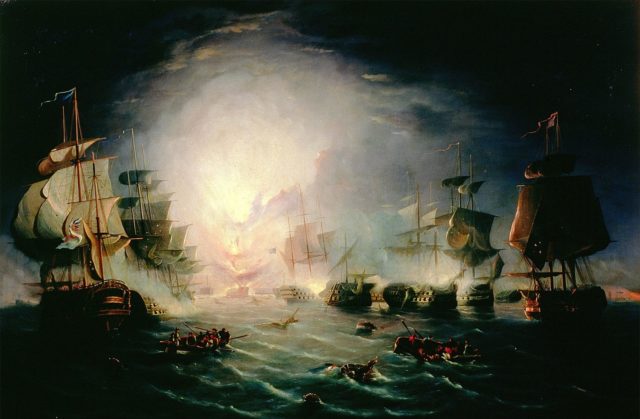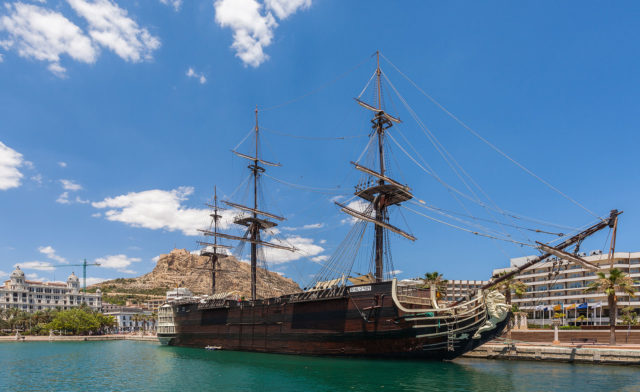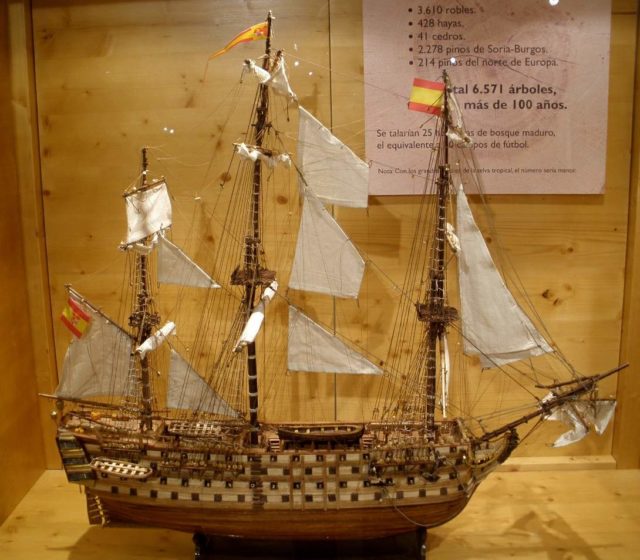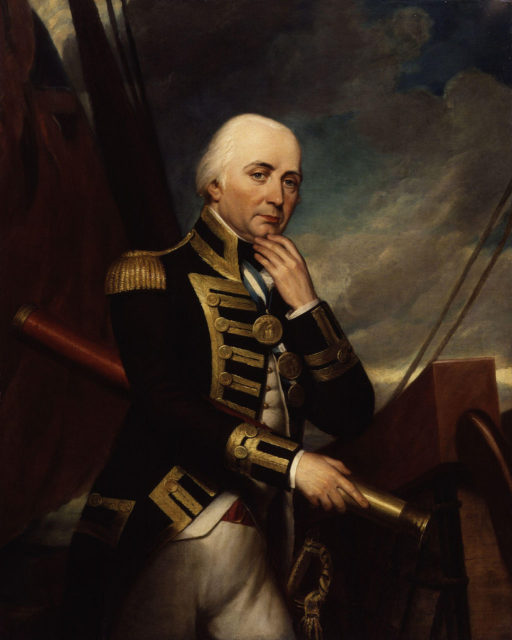Navies were crucial to the Napoleonic Wars. In the days before rail, ocean transport was vital to the trading economies of the European powers. Naval power was also important in retaining control of colonies and in bringing troops into action.
It was an age of great sailing ships, many of which played a crucial part in the war.
Victory
Launched in 1765, the Victory became famous due to her size, her part in the wars, and her later preservation as a museum ship.
A 100-gun British ship of the line, Victory was built at Chatham Dockyard under the supervision of John Lock and then Edward Allin. During decades of service, she acted as flagship for some naval commanders, including Keppel at Ushant and Howe at Cape Spartel.
By the time of the Napoleonic Wars, the Victory was no longer the most modern ship of the British line. She was still a very capable vessel and had been refitted to keep her up to date and in good repair. She was the vessel Nelson chose as his flagship in 1803, and he was aboard her for the action at Trafalgar in 1805.

It was Nelson’s greatest and final victory, as a shot fatally wounded him during the battle. Of her crew, 57 were killed and 102 injured. The Victory herself was severely damaged and had to be towed to port. She was repaired and continued to serve as a warship before becoming a training school and then a tourist attraction.
Check out this video of HMS Victory firing a rolling broadside.
Orient
Launched on July 20, 1791, the Orient came into service as France was entering a period of great upheaval. Her original name, the Dauphin Royal, was abandoned by the Republican French government. She served for three years as the Sans-Culotte, a tribute to a political movement, but that name also became contentious. At last, she became the Orient.
A large modern ship of 118 guns, the Orient served as flagship for Rear-Admiral Martin at the Battle of Genoa in 1795. In 1798, she was assigned as the flagship for one of the most disastrous French endeavors of the revolutionary and Napoleonic wars – the expedition to Egypt.

On August 2, 1798, Orient was among the French ships at anchor at the mouth of the River Nile. Attacked by the British under Admiral Nelson, the Orient came under fire from five ships. She caught fire, and her powder stores ignited, destroying the ship in a massive explosion that became the most famous incident in the battle. The number of men killed was disputed but was undoubtedly in the hundreds.
Santisima Trinidad

The ship with the greatest firepower in the wars was not produced by the French or British, but by the Spanish.
Launched in 1769, the Santisima Trinidad, and the second ship to bear the name, started out as a three-deck 112-gun ship. Already, this made her one of the most powerful ships on the seas, a symbol of the once glorious Spanish maritime empire. An empire which would collapse during the Santisima Trinidad’s time at sea.
In 1795, the forecastle and quarterdeck of the Santisima Trinidad were joined to form a fourth gun deck, unique among ships of the time. It took her up to a theoretical 140 guns, although they were reduced to 130. She was reputed to be the largest vessel on the seas.

The Santisima Trinidad served as Spanish flagship in 1797 at the Battle of Cape St Vincent. There she was badly damaged and almost captured by the British. Repaired at Cadiz, she returned to action.
The huge bulk of the vessel and her fourth gun deck made her infamously unwieldy when at sea. Although she took part in the Battle of Trafalgar, her lack of agility prevented her from playing a significant role in that engagement. Coming under attack from several British ships, she lost her main mast and was captured.
Taken in tow by the victorious British, the Santisima Trinidad was caught in a storm on the day after Trafalgar and sank.
Ville de Paris

Despite her name, the Ville de Paris was a British rather than a French ship. She was also one of the largest ships during the wars.
Launched in 1795 at Chatham Dockyard, the Ville de Paris was the only ship of her particular design to be built. An 110-gun ship of the line, she reflected the escalating quest for massive firepower among the navies taking part in the war.
The name Ville de Paris was a snub to the French, with whom the British were by now mired in a series of wars. The original Ville de Paris had been a French flagship captured by the British at the Battle of the Saintes in April 1782. On her voyage back to England that September, she was lost in a storm. If she had survived she would have been renamed and put into British service, as often happened with captured ships.
Naming a ship, the Ville de Paris was, therefore, a reminder to the French of their past failures. It was a title that cried out “we’re coming to take your ships.”
One of her most significant actions came not in battle but during a retreat. During the British withdrawal from the Iberian Peninsula after the Battle of Corunna, she evacuated thousands of British soldiers.
Like the Victory, the Ville de Paris was the site of the death of a famous admiral. In Admiral Collingwood’s case, it was not a musket ball but cancer that killed him in March 1810.
The Ville de Paris saw active service for nearly thirty years. In 1824 she was withdrawn to harbor service until she was broken up in 1845.
By then, naval warfare was starting to change. The great age of sail would soon pass, and survivors such as the Victory would be rarities and museum pieces.
Sources:
Rif Winfield (2005), British Warships in the Age of Sail.
